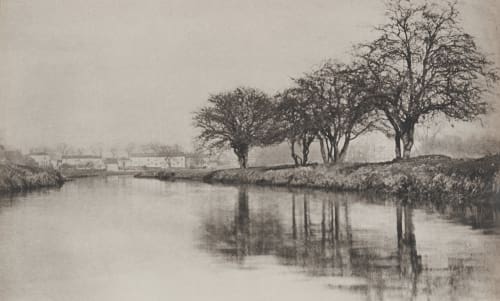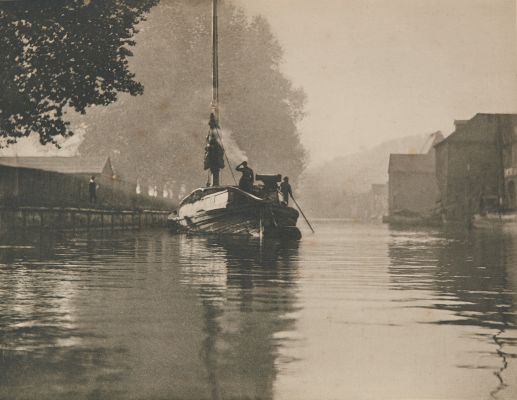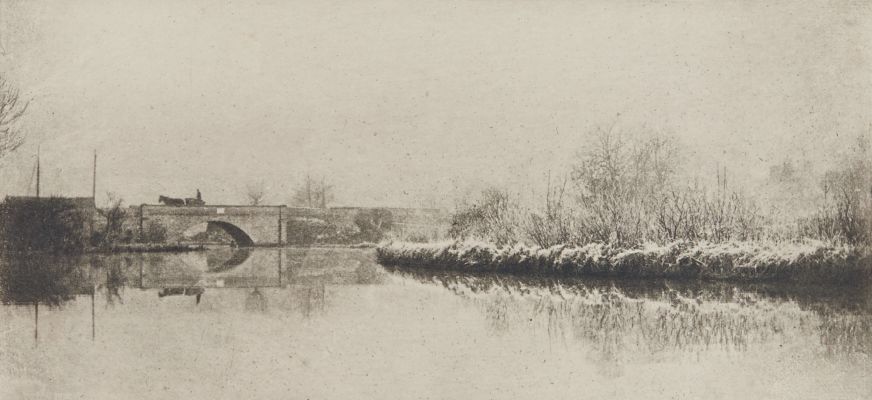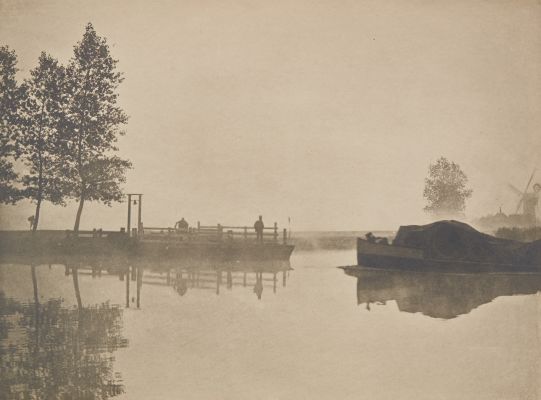
Title
The Village by the RiverArtist
Emerson, Peter Henry (British, 1856-1936)Key FigurePublication
On English LagoonsDate
1893Process
PhotogravureAtelier
Peter Henry EmersonImage Size
14 x 22.5 cm
The artist who works in photography must not rest until he has mastered photo-etching: then he is completely equipped, and ranks with the etcher…for in etchings of all kind the choice of papers and inks is most vital. I hope in the future to print my own plates which I see is the only satisfactory method. – Peter Henry Emerson.
Although Stieglitz would push photogravure to new creative heights in Camera Notes, the Englishman Peter Henry Emerson was the first to extensively use the process for artistic ends. In 1887 Emerson, a vocal exponent of Naturalistic photography, began publishing studies of the Norfolk Broads in books and portfolios illustrated with photogravure prints. By using his original negatives and closely supervising the printing of the images, he revealed the creative possibilities of a process that had been developed as just one more means of reproduction. Emerson found photogravure the "only satisfying" means of publishing his images and by the time this fifth album, On English Lagoons, was issued in 1893 he was printing his own photogravures. This devotion to craft as well as quality was greatly admired by Stieglitz. In 1899 Stieglitz proclaimed Emerson a great authority on pictorial photography, one to whom it owes more than any other man, referring to his accomplishments in photogravure as well as his contributions as a writer and image maker. [1]
On English Lagoons’ fifteen gravures are largely subordinate to the lengthy narrative text chronicling his year aboard a wherry, cruising East Anglian waters (1890-1891). The delicate, distant landscape vignettes that predominate here presage the chilly finality of those in Marsh Leaves. So too does their breathless quality of suspension of time and action, as in At the Ferry—A Misty Morning. [2]
Emerson personally learned the [photogravure] process from W. L. Colls, England’s leading practitioner of photogravure, then went on to etch the plates and print all the gravures that appeared in this book and Marsh Leaves.
Fifteen photo-engravings appear in the deuluxe edition only limited to 100 copies – 50 of which were assumed to be printed. This is Emerson’s most rare title.
Reproduced / Exhibited
Getty Object Number: 84.XB.696.10
National Gallery of Art Accession Number 2013.55.1.1-15
References
[1] Peterson Christian A et al. Alfred Stieglitz’s Camera Notes. 1st ed. Published by the Minneapolis Institute of Arts in Association with W.W. Norton 1993.
[2] Foster, Sheila J, Manfred Heiting, and Rachel Stuhlman. Imagining Paradise: The Richard and Ronay Menschel Library at George Eastman House, Rochester. Göttingen: Steidl, 2007 p. 192
Stevenson, Sara, and Duncan Forbes. A Companion Guide to Photography in the National Galleries of Scotland. Edinburgh: National Galleries of Scotland, 2009. p. 119











